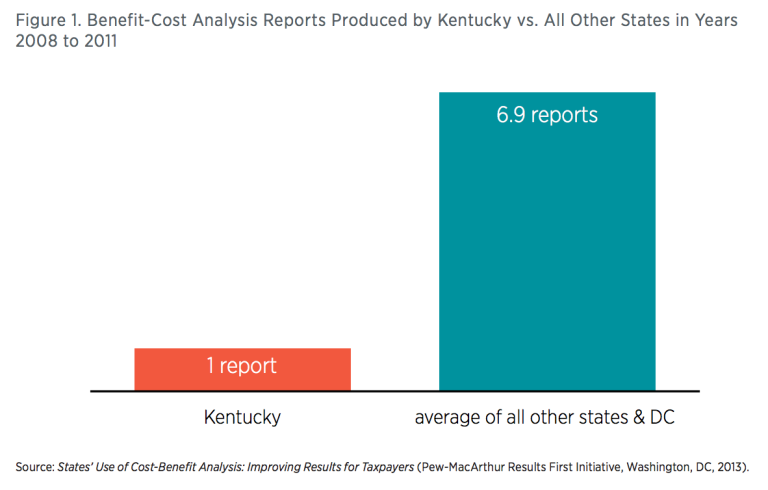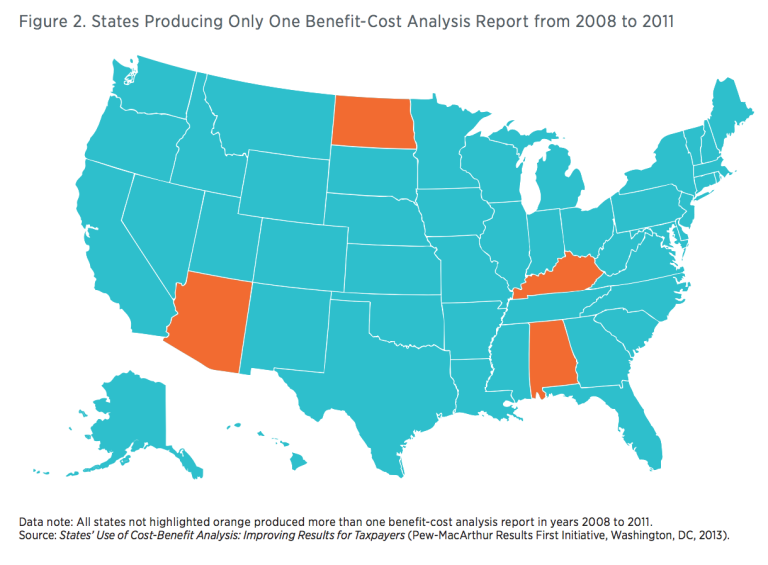- | Housing Housing
- | Policy Briefs Policy Briefs
- |
Kentucky Trails Most States in Production of Benefit-Cost Analysis
When it comes to advancing evidence-based policy, the US states are leaving a lot to be desired—especially Kentucky.
The Commonwealth of Kentucky, like other states, wants to make the most of its limited resources. To do so, its government must design policies that address real problems, are cost effective, and improve welfare for citizens. Kentucky could manage its resources more effectively if the state government conducted more benefit-cost analysis (BCA).
BCA is a tool used to organize information about the likely consequences of policy decisions. Analysts use BCA to assess the pros and cons of various policy options before acting in order to identify the most efficient option that delivers the best outcomes relative to cost. BCA helps policymakers make informed, rational decisions so that they may be good stewards of society’s wealth and resources.

In 2013, the Pew-MacArthur Results First Initiative released a report looking at the degree to which the 50 US states and the District of Columbia produce and use BCA. The report evaluated the states along three dimensions: the number of reports produced in the years 2008 to 2011, the scope of these reports as measured by the number of policy options considered, and whether there was evidence that BCA reports were used to inform budget and policy decisions.
Along every dimension, the state of Kentucky was found to be “trailing behind”—the worst rating a state could receive in the study. As figure 1 shows, Results First identified only one document in Kentucky in the relevant years that met the criteria for a BCA. Meanwhile, average BCA production for all other states plus DC during this period was just under seven reports, and the median number of reports was five.
Kentucky’s poor rating came despite legal requirements in the state, in place since at least the year 2000, for regulatory impact analysis (RIA) to be conducted for administrative regulations. These RIAs are required (since 2006) to identify the benefits and costs to individuals, businesses, and other parties affected by rules, but the analyses are too scant to meet Results First’s definition of what qualifies as a BCA.

Perhaps Kentucky has made gains since 2011, the last year of the Pew-MacArthur study. But even the best states had a lot of room for improvement. For example, Results First found that only 18 percent of state BCAs considered at least two alternative policy options in the analysis, and only about half of evaluated reports had any recognized impact on policymaking. Even well-performing states like Washington State used BCA primarily for evaluating policies other than administrative regulations, suggesting the social consequences of rulemaking are still largely unknown to regulators.
Underlying the use of BCA is the idea that government performance is improved when regulations are informed by solid evidence and careful decision-making. When it comes to advancing evidence-based policy, the US states are leaving a lot to be desired—especially Kentucky.
